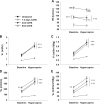Recovery of inspiratory intercostal muscle activity following high cervical hemisection
- PMID: 22705013
- PMCID: PMC4288928
- DOI: 10.1016/j.resp.2012.06.006
Recovery of inspiratory intercostal muscle activity following high cervical hemisection
Abstract
Anatomical and neurophysiological evidence indicates that thoracic interneurons can serve a commissural function and activate contralateral motoneurons. Accordingly, we hypothesized that respiratory-related intercostal (IC) muscle electromyogram (EMG) activity would be only modestly impaired by a unilateral cervical spinal cord injury. Inspiratory tidal volume (VT) was recorded using pneumotachography and EMG activity was recorded bilaterally from the 1st to 2nd intercostal space in anesthetized, spontaneously breathing rats. Studies were conducted at 1-3 days, 2 wks or 8 wks following C2 spinal cord hemisection (C2HS). Data were collected during baseline breathing and a brief respiratory challenge (7% CO(2)). A substantial reduction in inspiratory intercostal EMG bursting ipsilateral to the lesion was observed at 1-3 days post-C2HS. However, a time-dependent return of activity occurred such that by 2 wks post-injury inspiratory intercostal EMG bursts ipsilateral to the lesion were similar to age-matched, uninjured controls. The increases in ipsilateral intercostal EMG activity occurred in parallel with increases in VT following the injury (R=0.55; P<0.001). We conclude that plasticity occurring within a "crossed-intercostal" circuitry enables a robust, spontaneous recovery of ipsilateral intercostal activity following C2HS in rats.
Copyright © 2012. Published by Elsevier B.V.
Figures




Similar articles
-
Daily acute intermittent hypoxia elicits functional recovery of diaphragm and inspiratory intercostal muscle activity after acute cervical spinal injury.Exp Neurol. 2015 Apr;266:1-10. doi: 10.1016/j.expneurol.2015.02.007. Epub 2015 Feb 14. Exp Neurol. 2015. PMID: 25687551 Free PMC article.
-
Ipsilateral inspiratory intercostal muscle activity after C2 spinal cord hemisection in rats.J Spinal Cord Med. 2015 Mar;38(2):224-30. doi: 10.1179/2045772314Y.0000000220. Epub 2014 Jun 26. J Spinal Cord Med. 2015. PMID: 24969369 Free PMC article.
-
Diaphragm and Intercostal Muscle Activity after Mid-Cervical Spinal Cord Contusion in the Rat.J Neurotrauma. 2018 Feb 1;35(3):533-547. doi: 10.1089/neu.2017.5128. Epub 2017 Nov 30. J Neurotrauma. 2018. PMID: 28844175
-
Respiratory recovery following high cervical hemisection.Respir Physiol Neurobiol. 2009 Nov 30;169(2):94-101. doi: 10.1016/j.resp.2009.06.014. Epub 2009 Jun 26. Respir Physiol Neurobiol. 2009. PMID: 19560562 Free PMC article. Review.
-
Activation of inspiratory muscles via spinal cord stimulation.Respir Physiol Neurobiol. 2013 Nov 1;189(2):438-49. doi: 10.1016/j.resp.2013.06.001. Epub 2013 Jun 7. Respir Physiol Neurobiol. 2013. PMID: 23751522 Free PMC article. Review.
Cited by
-
A murine model of cervical spinal cord injury to study post-lesional respiratory neuroplasticity.J Vis Exp. 2014 May 28;(87):51235. doi: 10.3791/51235. J Vis Exp. 2014. PMID: 24894020 Free PMC article.
-
Spinal interneurons and forelimb plasticity after incomplete cervical spinal cord injury in adult rats.J Neurotrauma. 2015 Jun 15;32(12):893-907. doi: 10.1089/neu.2014.3718. Epub 2015 May 5. J Neurotrauma. 2015. PMID: 25625912 Free PMC article.
-
Common mechanisms of compensatory respiratory plasticity in spinal neurological disorders.Respir Physiol Neurobiol. 2013 Nov 1;189(2):419-28. doi: 10.1016/j.resp.2013.05.025. Epub 2013 May 28. Respir Physiol Neurobiol. 2013. PMID: 23727226 Free PMC article. Review.
-
Daily acute intermittent hypoxia elicits functional recovery of diaphragm and inspiratory intercostal muscle activity after acute cervical spinal injury.Exp Neurol. 2015 Apr;266:1-10. doi: 10.1016/j.expneurol.2015.02.007. Epub 2015 Feb 14. Exp Neurol. 2015. PMID: 25687551 Free PMC article.
-
Diaphragm muscle function following midcervical contusion injury in rats.J Appl Physiol (1985). 2019 Jan 1;126(1):221-230. doi: 10.1152/japplphysiol.00481.2018. Epub 2018 Sep 20. J Appl Physiol (1985). 2019. PMID: 30236045 Free PMC article.
References
-
- Baker-Herman TL, Fuller DD, Bavis RW, Zabka AG, Golder FJ, Doperalski NJ, Johnson RA, Watters JJ, Mitchell GS. BDNF is necessary and sufficient for spinal respiratory plasticity following intermittent hypoxia. Nature Neuroscience. 2004;7:48–55. - PubMed
-
- De Troyer A, Kirkwood PA, Wilson TA. Respiratory action of the intercostal muscles. Physiological Reviews. 2005;85:717–756. - PubMed
-
- Ditunno JF, Little JW, Tessler A, Burns AS. Spinal shock revisited: a four-phase model. Spinal Cord. 2004;42:383–395. - PubMed
Publication types
MeSH terms
Grants and funding
LinkOut - more resources
Full Text Sources
Medical
Miscellaneous

